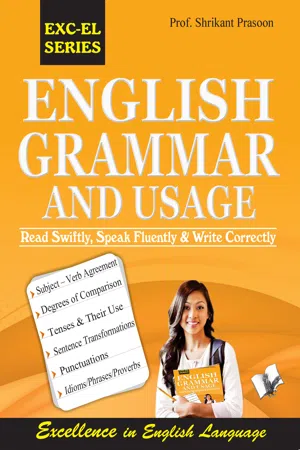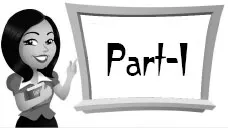![]()
Chopter 1
Parts of Speech -An Introduction
Words are divided into different kinds or classes, called parts of speech, according to their use; that - is, according to the work they do in a sentence. The parts of speech are eight in number:
| 1. Noun | 2. Adjective | 3. Pronoun | 4. Verb |
| 5. Adverb | 6. Preposition | 7. Conjunction | 8. Interjection |
A noun is a word used as a name of a person, place or thing as:
Akbar was a great king. Kolkata is also called the ’ City of Joy’ .
The rose smells sweet. The sun shines brightly.
His courage won him honour.
Note: All the words in italics are Nouns.
An adjective is a word used to add something to the meaning of a noun; as,
He is a brave boy.
There are twenty boys in this class.
Note: The words in italics are Adjectives.
A pronoun is a word used instead of a noun; as,
John is absent, because he is ill.
The books are where you left them.
Note: The words in italics are Pronouns.
A verb is a word used to say something about some person, place or thing; as,
The girl wrote a letter to her cousin.
Kolkata is a highly populated city.
Iron and copper are useful metals.
Note: The words in italics are Verbs.
Is and are, also called helping verbs.
An adverb is a word used to add something to the meaning of a verb, an adjective or another adverb; as,
Note: The words in italics are called Adverbs.
He worked the sum quickly. (Here, it is adding to the meaning of a verb)
This flower is very beautiful. (Here, it is adding to the meaning of an adjective)
She pronounced the word quite correctly. (Here, it is adding to the meaning of an adverb)
A preposition is a word used with a noun or a pronoun to show how the person or thing denoted by the noun or pronoun stands in relation to something else as,
There is a cow in the garden.
The girl is fond of music.
A fair little girl sat under a tree.
Note: In, of and under are called Prepositions.
A conjunction is a word used to join words or sentences together to form a single sentence; as,
Rama and Hari are cousins.
Two and two make four.
I ran fast but missed the train.
Note: All the words in italics are Conjunctions.
An interjection is a word which expresses some sudden feeling; as,
Hurrah! We have won the game.
Alas! She is dead.
Note: The words, Hurrah and Alas are called Interjections.
As words are divided into different classes according to the work they do in sentences, it is clear that we cannot say to which parts of speech a word belongs to unless we see it used in a sentence. They arrived soon after. (Adverb)
They arrived after us. (Preposition)
They arrived after we had left. (Conjunction)
From the above examples, we see that the same word can be used in different parts of speech.
1. Name the parts of speech of each italicised word in the following sentences, giving in each case your reason for the classification:
1. Still waters run deep.
2. He still lives in that house.
3. After the storm comes the calm.
4. The after effects of the drug are bad.
5. It weighs about a pound.
6. He told us all about the battle.
7. He was only a yard off me.
8. Suddenly, one of the wheels came off.
9. Mohammedans fast in the month of Ramzan.
10. He kept the fast for a week.
11. He is on the committee.
12. Let us move on.
13. Sit down an...


